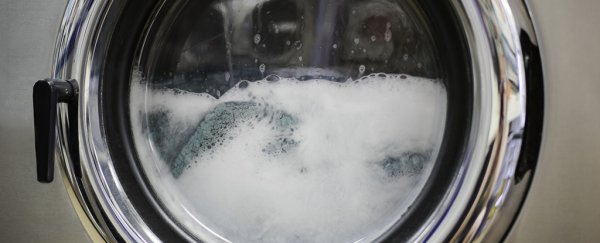Plenty of clothes can be washed perfectly well at cold temperatures - the more sustainable option when it comes to doing your laundry. But a recent superbug case documented in Germany reveals that sometimes it's best to just blast your garments in the hot cycle.
When inspections at a children's hospital revealed 13 newborns and one child were carrying the superbug Klebsiella oxytoca, an urgent investigation found that a washing machine on the same floor was to blame.
Researchers identified traces of the pathogen on the surfaces and leftover water from the washing machine. The bacteria appeared to have been passed on via the knitted hats and socks that went through the machine; these items were used to keep the babies warm.
Thankfully, none of the youngsters fell seriously ill, but it's a reminder of the need for strict guidelines and standards when it comes to cleaning clothes and other objects, especially where sick and vulnerable people are involved.
When the washing machine was removed, the K. oxytoca colonisation went away. The case study concludes that the final cold water rinse, which doesn't use detergent, may have allowed the bacteria to thrive. The humidity of the hospital rooms, allowing residual water to condense on the rubber seal of the door, probably didn't help either.
"This is a highly unusual case for a hospital, in that it involved a household type washing machine," says hygienist Ricarda Schmithausen, from the University of Bonn in Germany.
As Schmithausen points out, the machine in question did not meet current Germany hygienic standards for hospital use – though it was technically located outside the main laundry room, and only used for mothers' clothes and baby knitwear.
It's not clear exactly how the K. oxytoca arrived in the washing machine in the first place, but at least in this case, the consequences were minimal. An infection with this superbug can cause gastrointestinal and respiratory problems, and even death. There are few antibiotics left that we can use against it.
Of course, superbug risks at a hospital are markedly different from what you can expect in your own home. Low-temperature cycles are still perfectly fine for regular laundry, as long as you follow the washing instructions on your clothes.
But this case does show we may need to look into changes in washing machine design and processes to prevent these devices from harbouring superbugs, especially where sick patients are involved – and that applies to homes as well as hospitals.
"If elderly people requiring nursing care with open wounds or bladder catheters, or younger people with suppurating injuries or infections live in the household, laundry should be washed at higher temperatures, or with efficient disinfectants, to avoid transmission of dangerous pathogens," says hygienist Martin Exner, from the University of Bonn.
"This is a growing challenge for hygienists, as the number of people receiving nursing care from family members is constantly increasing."
The research has been published in the journal Applied and Environmental Microbiology.
